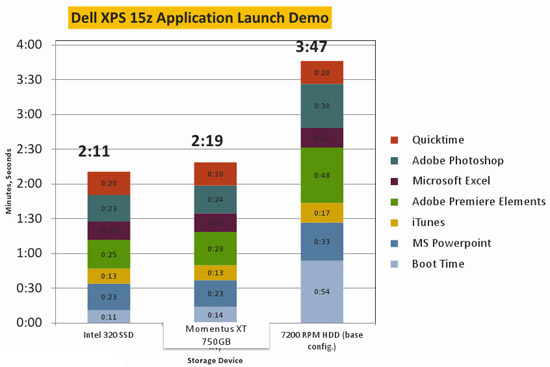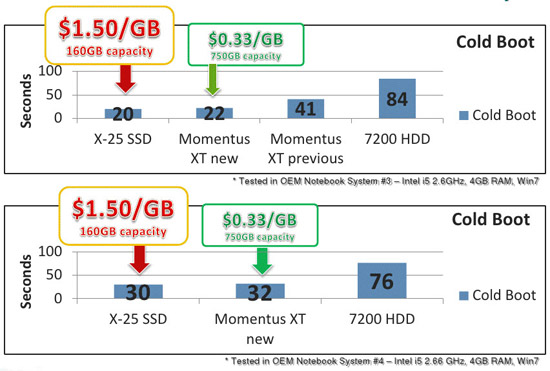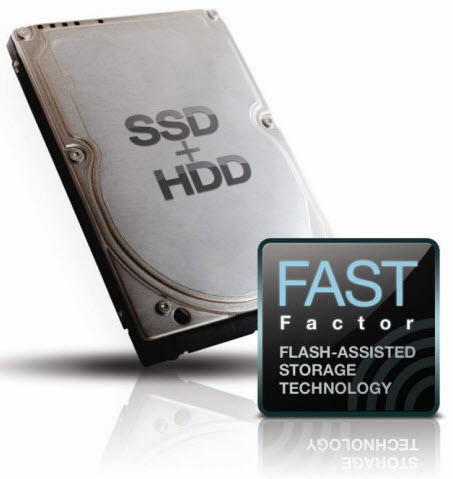Seagate Momentus XT 750GB Hybrid Drive Review (ST750LX003)
Final Thoughts and Conclusions
As we explained when looking at the non-XT version of the Momentus, hard drive manufacturers measure their drives in GB (1,000,000,000 bytes) but Windows reflects the logical measure of GiB (1,073,741,824 bytes). So, for the Seagate Momentus XT 750Gb drive, if you take the 750,153,363,456 bytes available, you end up with 698 GiB available. This does not include the SSD capacity on board. A lot of novice users have that WTF moment when viewing the capacity of the drive in Windows.

Interestingly, the Momentus XT is an old-school spinning platter hard drive trying its best to keep pace with the sleek and sporty SSDs by employing an solid state component paired with it’s algorithm based Adaptive Memory Technology. In some cases, it does a good job of this but overall the difference between this hybrid and a full out SSD is still night and day. Boot times were significantly improved which is a real pain point for a lot of users, as was the start up time of frequently used apps that tend to be slow to load. The latter is not something we can easily measure objectively with start times being so short to begin with but we saw some extra responsiveness when starting apps like Dreamweaver and MS Office along with opening larger files. Because only some data is cached, performance can be a little uneven as compared to a true SSD but it’s not really noticeable.
It’s important to note that the traditional benchmarks really didn’t take advantage of the SSD component and therefore the scores were more like that of a pure hard drive. Seagate told us as much going in, although that left us with limited options for comparisons. The algorithms just aren’t designed to maximize that kind of usage pattern. Seagate feels that this drive compares with the OCZ RevoDrive Hybrid, but we really see no such comparison. The RevoDrive Hybrid heartily trounced the Momentus XT drive just about every chance it got in the tests we ran. In fairness, the RevoDrive Hybrid has gobs more SSD capacity, costs twice as much, and it’s not like you can drop the PCI-E based drive in a notebook PC. Because of the expansive solid state capacity, it’s set up to cache way more data and therefore showed very good scores on the benchmarks. In general PC use, the RevoDrive Hybrid felt snappier and more responsive and it simply has more horsepower.

Don’t get the wrong idea, we think Seagate has a good product here and many users who can’t afford, don’t trust, or need more capacity from a true SSD can certainly benefit from the extra performance this hybrid drive offers as you can see from their marketing graphic above. We certainly could tell a difference in “normal” use over the traditional Momentus drive and even the older 500GB XT drive which is partially due to the SmartAlign feature that dynamically keeps the sector alignments at 4k, independent of the OS. The 750GB XT also has the SATA III interface which should prevent any kind of bottlenecks although we wonder if the SATA II interface was really a hindrance. Either way, it’s nice to have the headroom. Users can always look to the 10K or 15K RPM drives but with that comes additional unwanted inefficiencies with extra heat, noise and vibrations along with higher battery drain. Don’t forget the price premium.

In terms of cost, Seagate had originally given us one MSRP when they first gave us the information on the drive but by the time the NDA deadline came along, we were given a new MSRP of $245 which is higher than the first price given. There was no explanation for this but we assume that it has mainly to do with the climbing prices of hard drives due to supply issues resulting from the floods in Thailand. In fact, Seagate CEO Steve Luczo recently spoke about this in an interview. Even so, economically the Momentus XT 750GB is a bargain when compared to SSDs of the same capacity (if you can find one). That comes out to about $0.35 per usable GB which is a far cry from the $1.50 to $2.50 per usable GB we see with SSDs. They have also upped the warranty to five years which is 2 years more than what you’ll find on most SSDs.

Overall, we’d certainly recommend the Momentus XT and frankly wouldn’t go back to a plain old hard drive unless we were forced to. The expediency of boot and application load times are something that, once you get used to it, you can’t seem to live without. Keep in mind that it may take two or three times for the Adaptive Memory Technology to decide that it should be cached and speed things up. On the down side, every operation is not SSD fast, especially if you’re performing it for the first time. Levels in games may or may not load quicker depending on how much data is redundant from level to level and if it’s been awhile since you’ve opened an application, you may find yourself waiting just a bit longer. The 8GB of NAND on board is comparatively tiny against the 750GB platter so there’s a finite amount of data that can be cached as the algorithm sees fit. As NAND prices fall, we’ll probably see these type of drives incorporate larger amounts of solid state material that will allow for a looser threshold of what gets cached and what doesn’t and maximize the reads coming from the solid state portion of the drive.

Legit Bottom Line: Unless you need a larger capacity drive, we really can’t find a reason why your next OS hard drive shouldn’t be a Momentus XT

Comments are closed.